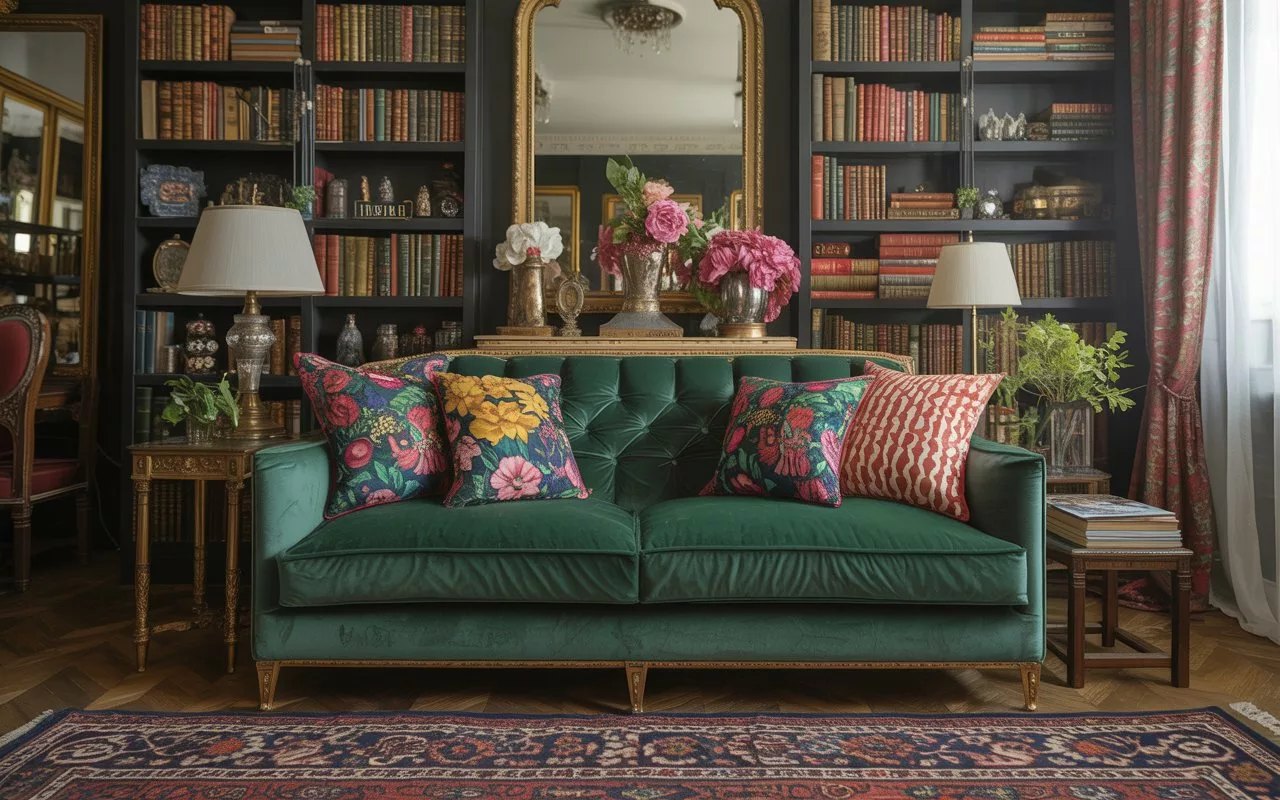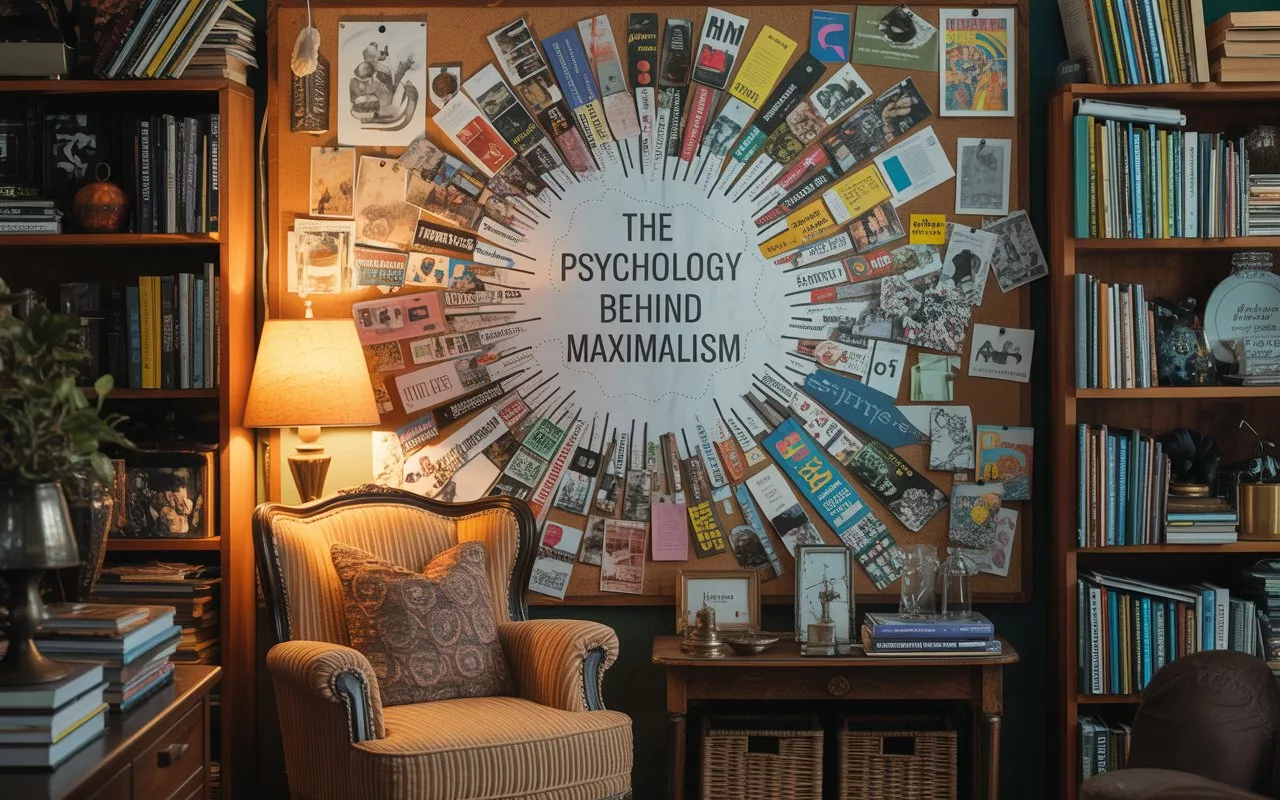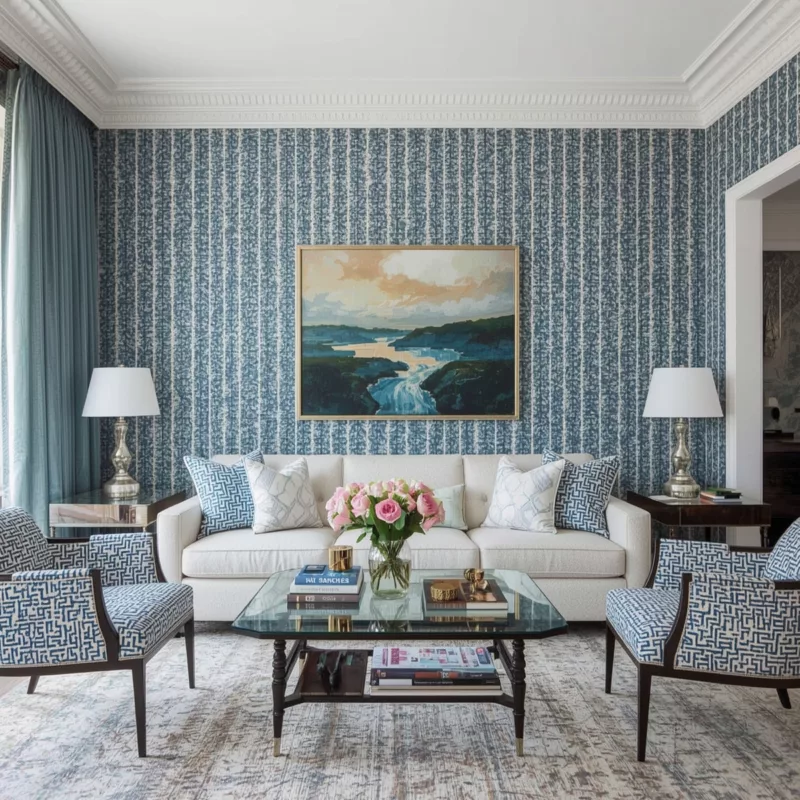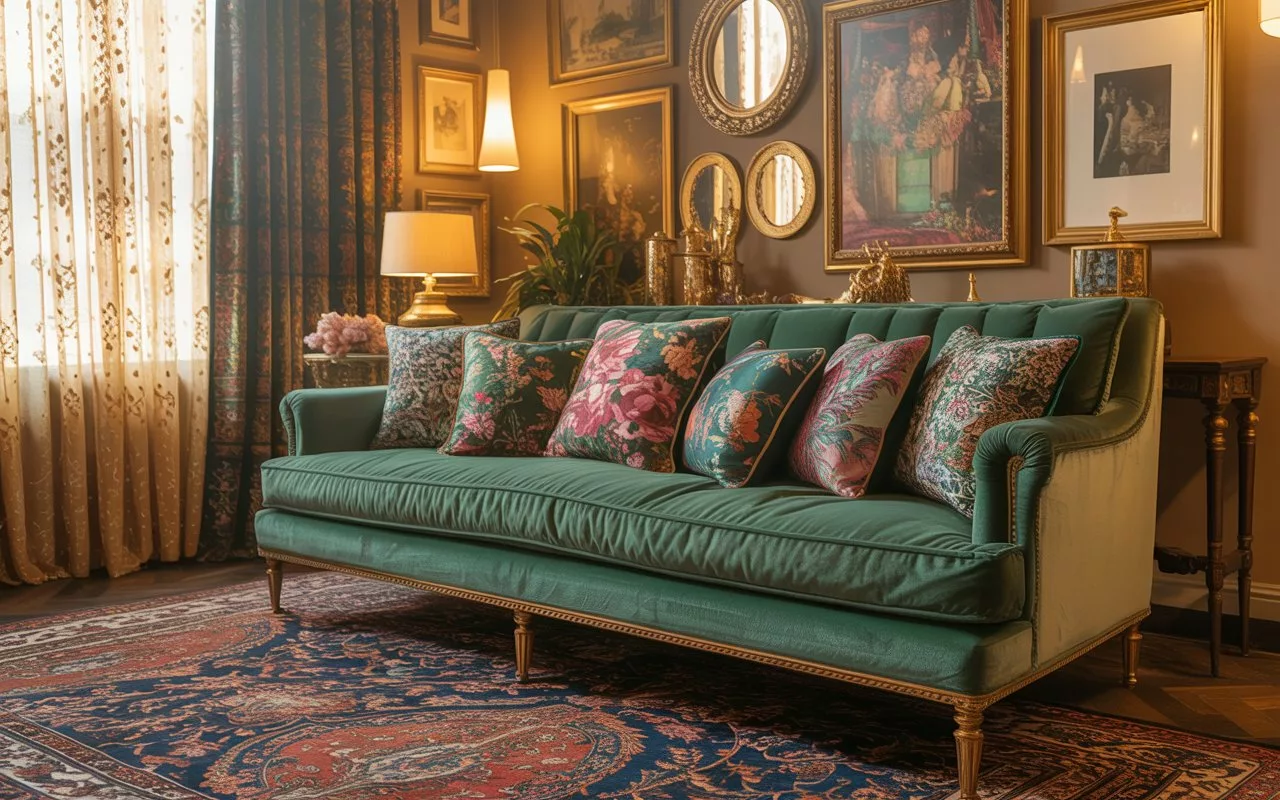Table of Contents
- Introduction to Maximalism
- Understanding Bold Patterns in Maximalist Design
- The Psychology Behind Maximalism
- Essential Principles of Smart Pattern Integration
- Color Theory in Maximalist Spaces
- Layering Techniques for Bold Patterns
- Room-by-Room Maximalist Applications
- Furniture Selection for Maximalist Interiors
- Textile and Fabric Coordination
- Lighting Strategies for Pattern-Heavy Spaces
- Common Maximalism Mistakes to Avoid
- Maximalism vs. Minimalism: Finding Balance
- Budget-Friendly Maximalist Design Tips
- Cultural Influences in Maximalist Design
- Sustainable Maximalism Practices
- Technology Integration in Maximalist Homes
- Conclusion and Final Thoughts
Introduction to Maximalism
Maximalism represents a bold departure from the minimalist trends that have dominated interior design for decades. This design philosophy embraces the concept that “more is more,” celebrating abundance, personality, and visual richness in living spaces. Unlike its minimalist counterpart, maximalism encourages homeowners to showcase their collections, mix patterns fearlessly, and create environments that tell compelling stories through layered design elements.
The maximalist movement has gained significant traction among interior designers and homeowners who seek to express their individuality through their living spaces. This approach to design doesn’t simply mean cramming as many items as possible into a room; rather, it requires careful curation and thoughtful integration of bold patterns, vibrant colors, and diverse textures to create cohesive, visually stunning environments.
Maximalism allows for personal expression on an unprecedented scale, encouraging inhabitants to surround themselves with objects, patterns, and colors that bring them joy and reflect their unique personalities. This design philosophy celebrates eclecticism, encouraging the mixing of different eras, styles, and cultural influences within a single space.
Understanding Bold Patterns in Maximalist Design

Bold patterns serve as the backbone of maximalism, providing visual interest, energy, and personality to interior spaces. These patterns can range from geometric designs and florals to abstract motifs and cultural prints, each contributing to the overall narrative of the room.
The key to successfully incorporating bold patterns lies in understanding their visual weight, scale, and interaction with other design elements. Large-scale patterns tend to dominate a space and should be balanced with smaller-scale designs or solid colors. Conversely, busy small patterns can create visual texture and depth when used strategically throughout a room.
Maximalism thrives on pattern mixing, but this doesn’t mean randomly combining any patterns that catch your eye. Successful pattern integration requires an understanding of how different designs complement or contrast with each other, creating visual harmony despite apparent chaos.
Pattern density plays a crucial role in maximalist design. High-density patterns with intricate details work well in spaces designed for contemplation or relaxation, while bold, simple patterns are better suited for active areas where movement and energy are desired.
The Psychology Behind Maximalism

The psychological appeal of maximalism stems from its ability to create environments that stimulate creativity, evoke memories, and provide comfort through familiar objects and patterns. Unlike minimalist spaces, which can sometimes feel cold or impersonal, maximalist interiors offer warmth and personality that many people find psychologically satisfying.
Research in environmental psychology suggests that people who gravitate toward maximalist design often have personalities that embrace complexity, novelty, and sensory stimulation. These individuals typically find comfort and inspiration in visually rich environments that offer multiple focal points and layers of meaning.
Maximalism can also serve as a form of self-expression and identity reinforcement. By surrounding themselves with meaningful objects, bold patterns, and vibrant colors, individuals create spaces that reflect their values, experiences, and aspirations. This personal connection to one’s environment can significantly impact mood, creativity, and overall well-being.
The concept of “visual abundance” in maximalist design can trigger positive psychological responses, including increased energy levels, enhanced creativity, and improved mood. However, it’s important to note that successful maximalist design requires careful balance to avoid overwhelming the senses or creating visual chaos that could have negative psychological effects.
Essential Principles of Smart Pattern Integration

Smart pattern integration in maximalism follows several key principles that ensure visual cohesion while maintaining the bold, expressive nature of the design philosophy. The first principle involves establishing a unifying element, such as a consistent color palette or recurring motif, that threads through all patterns used in the space.
The scale variation principle suggests mixing patterns of different sizes to create visual hierarchy and prevent any single pattern from overwhelming the space. Large-scale patterns should be balanced with medium and small-scale designs, creating a rhythmic flow throughout the room.
Color coordination serves as another crucial principle in maximalism. While the palette may be bold and varied, successful maximalist spaces maintain some form of color relationship between patterns, whether through complementary colors, analogous schemes, or repeated accent colors that appear across multiple patterns.
The 60-30-10 rule can be adapted for maximalist spaces, where 60% of patterns might share a common base color, 30% introduce a secondary color family, and 10% provide accent colors that add surprise and energy to the overall composition.
Visual breathing room, even in maximalist design, prevents sensory overload. This can be achieved through strategic use of solid colors, neutral areas, or simplified patterns that allow the eye to rest between more complex design elements.
Color Theory in Maximalist Spaces
Color theory becomes particularly important in maximalism, where multiple hues must work together harmoniously despite their intensity and variety. Understanding the relationships between colors helps create cohesive maximalist spaces that feel intentional rather than chaotic.
Warm color palettes featuring reds, oranges, and yellows create energetic, welcoming maximalist environments that encourage social interaction and activity. These colors work particularly well in living areas, dining rooms, and kitchens where people gather and engage with one another.
Cool color schemes incorporating blues, greens, and purples can create sophisticated maximalist spaces that feel more calming and contemplative. These palettes work well in bedrooms, studies, and other areas designed for relaxation or focused work.
Maximalism often benefits from the strategic use of neutral anchors—beige, cream, gray, or black elements that provide visual stability amid bold color combinations. These neutrals can appear in larger furniture pieces, wall colors, or flooring materials.
The concept of color temperature consistency helps create cohesion in maximalist spaces. Mixing warm and cool tones requires careful balance, often achieved through the strategic placement of transitional colors that bridge temperature differences.
Metallic accents in gold, silver, copper, or brass can serve as unifying elements in maximalist color schemes, providing consistency and sophistication while complementing both warm and cool color families.
Layering Techniques for Bold Patterns
Effective pattern layering in maximalism requires understanding how different designs interact visually and spatially. The foundation layer typically consists of larger, more subdued patterns that establish the room’s basic character and color palette.
The accent layer introduces bolder, more distinctive patterns through smaller elements like throw pillows, artwork, or decorative accessories. This layer adds personality and visual interest without overwhelming the space’s foundational elements.
Texture layering complements pattern layering in maximalism, with different fabric textures, surface finishes, and material contrasts adding depth and sophisticated complexity to the overall design composition.
Scale progression creates visual flow in pattern-heavy maximalist spaces. Starting with large-scale patterns and gradually incorporating smaller designs creates a sense of movement and prevents any single pattern from dominating the visual field.
The principle of odd numbers applies to pattern layering, where groupings of three or five different patterns tend to create more visually appealing and dynamic compositions than even-numbered groupings.
Strategic repetition of patterns throughout a space creates cohesion and intentionality in maximalist design. A pattern that appears in curtains might be echoed in a smaller scale on throw pillows or artwork, creating visual connections across the room.
Room-by-Room Maximalist Applications
Maximalism manifests differently in various rooms, with each space requiring tailored approaches to pattern integration and design intensity. Living rooms serve as the primary canvas for maximalist expression, accommodating large-scale furniture, bold wall treatments, and extensive pattern mixing.
In maximalist living rooms, the sofa often serves as an anchor piece, either featuring bold patterns itself or providing a neutral foundation for patterned accessories. Multiple seating options with different patterns and textures create conversation areas that encourage social interaction.
Kitchen maximalism focuses on combining functional elements with bold design choices. Patterned backsplashes, colorful cabinetry, and decorative accessories transform utilitarian spaces into expressive environments that celebrate both form and function.
Maximalism in bedrooms requires careful balance between stimulation and rest. While patterns and colors should reflect personal style, they should also support the room’s primary function as a space for relaxation and sleep.
Bathroom maximalism might seem contradictory, but small spaces can accommodate bold patterns through wallpaper, colorful tiles, and decorative accessories. The key lies in maintaining functionality while adding personality through carefully chosen design elements.
Home office maximalism can enhance creativity and productivity through inspiring color combinations and stimulating patterns. However, the design should support focus and concentration rather than creating distractions.
Furniture Selection for Maximalist Interiors
Furniture selection in maximalism involves balancing statement pieces with supporting elements that enhance rather than compete with bold patterns and colors. Large furniture pieces often serve as anchors, providing stability and grounding for more dynamic decorative elements.
Upholstered furniture in maximalist spaces can either feature bold patterns that serve as focal points or solid colors that provide visual rest areas. The choice depends on the overall pattern density and the desired visual hierarchy within the room.
Mixed furniture styles contribute to the eclectic nature of maximalism. Combining vintage pieces with contemporary designs, different wood finishes, and varied material textures creates layered, collected-over-time aesthetics that feel personal and authentic.
Storage furniture becomes particularly important in maximalist spaces, where numerous decorative objects and personal items require organization. Built-in shelving, display cabinets, and decorative storage solutions help maintain order while showcasing collections.
Scale variation in furniture selection prevents monotony and creates visual interest in maximalist rooms. Mixing large and small pieces, tall and low elements, and different furniture proportions contributes to the dynamic energy characteristic of this design approach.
Maximalism encourages the use of furniture as display surfaces for collections, books, artwork, and decorative objects. Coffee tables, side tables, and shelving units become part of the overall design composition rather than simply functional elements.
Textile and Fabric Coordination
Textiles play a crucial role in maximalism, providing opportunities for pattern mixing, texture variation, and color coordination throughout interior spaces. The strategic selection and placement of fabrics can make or break a maximalist design scheme.
Curtain and drapery fabrics in maximalist rooms often feature bold patterns or rich colors that complement the overall design scheme. These large fabric expanses provide opportunities for introducing major patterns or reinforcing color themes established elsewhere in the room.
Upholstery fabrics require careful consideration of durability, pattern scale, and color coordination. High-traffic furniture pieces might feature smaller, more forgiving patterns, while accent chairs can showcase bolder designs that serve as artistic focal points.
Maximalism embraces the mixing of different textile textures, from smooth silks and cottons to nubby tweeds and plush velvets. This textural variety adds depth and sophistication to pattern-heavy design schemes.
Throw pillows and cushions provide flexible opportunities for pattern experimentation in maximalist spaces. These easily changeable elements allow for seasonal updates and ongoing design evolution without major investment or commitment.
Area rugs serve as foundation elements in maximalist rooms, either providing neutral grounding for bold furniture and accessories or featuring prominent patterns that establish the room’s design direction.
Layering different textiles creates rich, complex surfaces that invite touch and examination. Combining various fabrics, from rough to smooth, matte to shiny, adds sensory appeal to the visual richness of maximalist design.
Lighting Strategies for Pattern-Heavy Spaces
Lighting design becomes crucial in maximalism, where proper illumination can enhance pattern visibility and create appropriate ambiance for visually complex spaces. Multiple light sources at different levels prevent harsh shadows and ensure even illumination of decorative elements.
Ambient lighting provides overall illumination for maximalist spaces, often achieved through ceiling fixtures, recessed lighting, or large table lamps. This foundational lighting should be sufficient but not overpowering, allowing patterns and colors to appear true and vibrant.
Task lighting in maximalist spaces serves functional purposes while adding to the overall design aesthetic. Desk lamps, reading lights, and kitchen task lighting can feature decorative elements that complement the room’s bold design themes.
Maximalism benefits from accent lighting that highlights specific design elements, artwork, or architectural features. Track lighting, picture lights, and strategically placed spotlights can draw attention to favorite pieces and create visual hierarchy.
Natural light management requires careful consideration in pattern-heavy spaces. Window treatments should control light intensity and direction while complementing the room’s overall design scheme. Light-filtering fabrics can soften harsh sunlight while maintaining pattern visibility.
Decorative lighting fixtures themselves become part of the maximalist composition. Chandeliers, pendant lights, and unique table lamps contribute to the room’s personality while providing necessary illumination.
Color temperature consistency in lighting helps maintain color accuracy in maximalist spaces where pattern and color relationships are critical. Warm or cool light sources should be used consistently throughout a space to prevent color distortion.
Common Maximalism Mistakes to Avoid
While maximalism encourages bold expression, several common mistakes can undermine the success of this design approach. Understanding these pitfalls helps create more successful and livable maximalist spaces.
The biggest mistake in maximalist design involves confusing clutter with intentional abundance. True maximalism requires curation and thoughtful placement of objects, patterns, and colors rather than simply accumulating items without consideration for their visual impact or functional purpose.
Ignoring scale relationships can create visual chaos in maximalist spaces. Mixing too many large-scale patterns or failing to provide adequate contrast between pattern sizes can overwhelm viewers and create uncomfortable environments.
Color coordination mistakes occur when designers or homeowners abandon all color relationships in favor of using every appealing color simultaneously. Successful maximalism requires some form of color harmony, even when using bold, varied palettes.
Neglecting visual rest areas creates sensory overload that can make maximalist spaces feel exhausting rather than energizing. Even the boldest maximalist designs require some areas where the eye can rest and recover from intense visual stimulation.
Proportional mistakes happen when small spaces are treated with the same intensity as large rooms. Maximalism must be scaled appropriately to room size and function to remain comfortable and livable.
Functionality sacrifices for aesthetic impact can render maximalist spaces impractical for daily use. The most successful maximalist designs balance bold visual appeal with practical considerations for how the space will be used.
Maximalism vs. Minimalism: Finding Balance
The relationship between maximalism and minimalism doesn’t have to be adversarial. Many successful interior designs incorporate elements from both philosophies, creating balanced environments that offer both visual richness and functional clarity.
Selective maximalism applies bold design principles to specific areas or rooms while maintaining more restrained approaches in others. This strategy allows homeowners to experiment with maximalism without overwhelming their entire living environment.
Transitional spaces between maximalist and minimalist areas require careful design consideration. Hallways, entryways, and connecting areas can serve as visual bridges that ease the transition between different design intensities.
Maximalism can be achieved through careful curation rather than overwhelming abundance. Choosing fewer, higher-quality pieces with bold patterns and colors can create maximalist impact without sacrificing livability or functionality.
Seasonal adjustments allow homeowners to experience both design philosophies throughout the year. Winter months might call for more maximalist approaches with rich textures and warm colors, while summer seasons could benefit from more minimal, streamlined arrangements.
Personal comfort levels vary significantly, and successful interior design must accommodate individual preferences and lifestyle needs. Some people thrive in maximalist environments, while others require more visual calm to feel comfortable and relaxed.
Budget-Friendly Maximalist Design Tips
Creating stunning maximalist interiors doesn’t require unlimited budgets. Strategic shopping, DIY projects, and creative repurposing can achieve maximalism goals without excessive spending.
Thrift stores, estate sales, and vintage shops offer treasure troves of unique pieces perfect for maximalist design. These sources provide access to distinctive patterns, unusual objects, and one-of-a-kind items that contribute to the eclectic nature of maximalist spaces.
DIY pattern creation through stenciling, fabric painting, or wallpaper application allows budget-conscious decorators to achieve custom looks without designer price tags. These projects also ensure that patterns perfectly match the desired color scheme and design vision.
Maximalism benefits from the creative repurposing of existing items through painting, reupholstering, or creative styling. Furniture pieces, decorative objects, and textiles can be transformed to fit new design schemes through relatively simple and inexpensive modifications.
Layering inexpensive items can create rich, complex looks that rival high-end design schemes. Multiple affordable throw pillows, inexpensive artwork, and budget-friendly accessories can combine to create sophisticated maximalist environments.
Seasonal shopping strategies help maximize budgets while building maximalist collections over time. End-of-season sales, clearance events, and holiday promotions provide opportunities to acquire quality pieces at reduced prices.
Free or low-cost resources like plant propagation, nature collecting, and creative displays using personal items can add personality and visual interest to maximalist spaces without straining budgets.
Cultural Influences in Maximalist Design
Maximalism draws inspiration from diverse cultural traditions that celebrate abundance, pattern, and color in interior design. Understanding these influences can inform and enrich contemporary maximalist approaches.
Moroccan design traditions contribute rich patterns, vibrant colors, and luxurious textures to maximalist vocabulary. Traditional Moroccan interiors layer geometric patterns, bold colors, and metallic accents to create opulent environments that celebrate sensory abundance.
Indian design influences bring complex patterns, jewel tones, and intricate details to maximalist spaces. Traditional Indian textiles, carved furniture, and decorative objects offer inspiration for creating rich, layered interiors that reflect centuries of artistic tradition.
Maximalism finds expression in Victorian design principles that celebrated ornate decoration, pattern mixing, and elaborate color schemes. Contemporary interpretations of Victorian maximalism can incorporate these historical influences while adapting them for modern living.
Bohemian design traditions contribute to maximalist approaches through their embrace of eclectic mixing, global influences, and personal expression. Boho maximalism combines elements from various cultures and time periods to create unique, individualized environments.
Mid-century maximalism represents a more restrained version of the design philosophy, incorporating bold patterns and colors within the clean lines and functional focuses characteristic of mid-century modern design.
Contemporary global influences continue to shape maximalism, with designers and homeowners drawing inspiration from diverse cultures, travel experiences, and international design movements to create personally meaningful maximalist spaces.
Sustainable Maximalism Practices
Sustainable maximalism focuses on creating rich, abundant interiors while maintaining environmental responsibility and ethical consumption practices. This approach requires thoughtful consideration of sourcing, longevity, and environmental impact.
Quality over quantity principles guide sustainable maximalist purchasing decisions. Investing in well-made pieces that will last for years or decades provides better long-term value while reducing environmental impact compared to frequently replacing lower-quality items.
Vintage and antique shopping supports sustainable maximalism by giving new life to existing items rather than contributing to demand for newly manufactured goods. These pieces often feature better construction and unique character that enhances maximalist design goals.
Local sourcing reduces transportation environmental costs while supporting community artisans and businesses. Local pottery, textiles, artwork, and furniture can provide distinctive elements for maximalist spaces while minimizing environmental impact.
Maximalism can incorporate upcycling and repurposing projects that transform discarded items into unique design elements. Creative reuse projects reduce waste while adding personal touches and conversation pieces to interior spaces.
Natural and renewable materials align with sustainable maximalist principles while providing rich textures and colors. Bamboo, cork, reclaimed wood, and natural fiber textiles offer environmentally responsible options for maximalist design elements.
Energy-efficient lighting and appliances ensure that visually rich maximalist spaces don’t compromise environmental responsibility for aesthetic impact. LED lighting, energy-efficient fixtures, and smart home technologies can reduce environmental impact without sacrificing design goals.
Technology Integration in Maximalist Homes
Modern maximalism must address the integration of technology into visually complex interior environments. Smart home systems, entertainment equipment, and digital devices can either complement or compete with maximalist design elements.
Concealed technology solutions help maintain the aesthetic integrity of maximalist spaces while providing modern convenience and functionality. Hidden speakers, concealed televisions, and integrated smart home controls prevent technology from disrupting carefully planned design compositions.
Decorative technology housing transforms necessary electronic equipment into design elements that contribute to rather than detract from maximalism goals. Custom cabinetry, decorative screens, and artistic concealment solutions can make technology part of the overall design story.
Smart lighting systems enhance maximalist spaces by providing precise control over illumination intensity, color temperature, and timing. These systems can highlight different design elements throughout the day or create various moods for different activities and occasions.
Maximalism can incorporate vintage technology as decorative elements that add character and historical interest to contemporary spaces. Antique radios, vintage cameras, and retro appliances can serve as both functional items and artistic focal points.
Digital art displays and smart picture frames allow maximalist spaces to incorporate changing visual elements while maintaining design flexibility. These technologies enable homeowners to update their spaces seasonally or according to mood without physical rearrangement.
Home automation systems can manage the complexity of maximalist environments by controlling lighting, climate, and security systems from centralized interfaces, ensuring that rich, complex spaces remain comfortable and livable.
Conclusion
Maximalism represents a bold and expressive approach to interior design that celebrates abundance, personality, and visual richness. Successfully integrating bold patterns in maximalist spaces requires understanding principles of color theory, scale relationships, and visual hierarchy while maintaining awareness of functionality and livability.
The key to mastering maximalism lies in thoughtful curation rather than random accumulation. Every pattern, color, and object should contribute to the overall design narrative while maintaining harmony with surrounding elements. This approach ensures that maximalist spaces feel intentional and sophisticated rather than chaotic or overwhelming.
Cultural influences, sustainable practices, and technological integration demonstrate that maximalism continues to evolve and adapt to contemporary living needs while maintaining its core principles of abundance and self-expression. Whether implemented throughout an entire home or confined to specific spaces, maximalism offers opportunities for creative expression that minimalist approaches cannot match.
The future of maximalism lies in its ability to balance bold visual impact with environmental responsibility, technological integration, and practical living requirements. As design trends continue to evolve, maximalism’s emphasis on personal expression and cultural richness ensures its continued relevance for homeowners seeking alternatives to stark minimalism.
Ultimately, successful maximalism creates spaces that reflect inhabitants’ personalities, celebrate their interests and collections, and provide environments that inspire creativity and joy. By understanding and applying the principles outlined in this comprehensive guide, anyone can create maximalist spaces that are both visually stunning and beautifully livable.
Whether you’re drawn to the cultural richness of globally-inspired maximalism, the nostalgic appeal of vintage-influenced designs, or the cutting-edge possibilities of contemporary maximalist approaches, the key lies in embracing abundance while maintaining thoughtful design principles that ensure beauty, functionality, and personal satisfaction in your living environment.
For more interior design inspiration and professional design services, explore our extensive collection of maximalist design projects and expert consultations.

